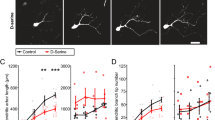Summary
-
1.
The tectum of Xenopus receives visuotopic input from both eyes. The contralateral eye's projection reaches the tectum directly, via the optic nerve. The ipsilateral eye's projection reaches the tectum indirectly, via the nucleus isthmi and isthmotectal projection.
-
2.
Because of the multi-synaptic nature of the ipsilateral pathway, there is an inherent delay between the time that information from the contralateral eye reaches the tectum and the time that information from the ipsilateral eye arrives at the tectum. The length of the intertectal delay is a function of the latencies of the contralateral and ipsilateral pathways.
-
3.
The length of this intertectal delay has functional, as well as developmental, implications with regard to the role of N-methyl-D-aspartate receptors in tectal cell activity and development of orderly synaptic connections.
-
4.
We have found that the latencies of the contralateral and ipsilateral pathways exhibit a seasonal variation, increasing during the winter months. The increases of both latencies during the winter were of similar magnitude, indicating that there were no significant changes in intertectal delay. The seasonal alteration in contralateral latency was not affected by dark-rearing and was affected to only a minor extent by a week-long alteration of ambient temperature.
Similar content being viewed by others
Abbreviations
- NMDA :
-
(N-methyl-D-aspartate)
References
Branston NM, Fleming DG (1968) Efferent fibers in the frog optic nerve. Exp Neurol 20:611–623
Byzov AL, Utina IA (1971) Centrifugal effect on amacrine cells in frog retina. Neirophyziol 3:293–300
Chung S-H, Bliss TVP, Keating MJ (1974) The synaptic organization of optic afferents in the amphibian tectum. Proc R Soc Lond B 187:421–447
Dowben RM, Rose JE (1953) A metal-filled microelectrode. Science 118:22–24
Dulhunty A, Gage P (1973) Electrical properties of toad sartorius muscle fibres in summer and winter. J Physiol 230:619–641
Dumuis A, Sebben M, Haynes L, Pin J-P, Bockaert J (1988) NMDA receptors activate the arachidonic acid cascade system in striatal neurons. Nature 336:68–70
East SJ, Garthwaite J (1991) NMDA receptor activation in rat hippocampus induces cyclic GMP formation through the Larginine-nitric oxide pathway. Neurosci Lett 123:17–19
Ewert J-P, Siefert G (1974) Neuronal correlates of seasonal changes in contrast-detection of prey catching behaviour in toads (Bufo bufo L.). Vision Res 14:431–432
Freeman EJ, Terrian DM, Dorman RV (1990) Presynaptic facilitation of glutamate release from isolated hippocampal mossy fiber nerve endings by arachidonic acid. Neurochem Res 15:743–750
Garthwaite J (1991) Glutamate, nitric oxide and cell-cell signalling in the nervous system. Trends Neurosci 14:60–67
Grant S, Keating MJ (1986) Normal maturation involves systematic changes in binocular visual connections in Xenopus. Nature 322:258–261
Grant S, Brickley SG, Keating MJ (1991) Plasticity of binocular connections in the frog. In: Sharma SC (ed) Formation and regeneration of nerve connections. Birkhäuser, Boston, submitted for publication
Gustafsson B, Wigström H (1986) Hippocampal long-lasting potentiation produced by pairing single volleys and brief conditioning tetani evoked in separate afferents. J Neurosci 6:1575–1582
Holzapfel RA (1937) The cyclic character of hibernation in frogs. Q Rev Biol 12:65–89
Lewis CA (1984) Seasonal changes in the properties of frog endplate channels. Biophys J 46:273–276
Maturana HR (1958) Efferent fibers in the optic nerve of the toad Bufo bufo. J Anat 92:21–26
McDonald JW, Cline HT, Constantine-Paton M, Maragos WF, Johnston MV, Young AB (1989) Quantitative autoradiographic localization of NMDA, quisqualate and PCP receptors in the frog tectum. Brain Res 482:155–158
McNaughton BL (1983) Activity-dependent modulation of hippocampal efficacy: Some implications for memory processes. In: Seifert W (ed) Molecular, cellular and behavioral neurobiology of the hippocampus. Academic Press, New York, pp 233–293
Mizell S (1965) Seasonal changes in energy reserves in the common frog, Rana pipiens. J Cell Comp Physiol 66:251–258
Park C (1989) Effects of essential fatty acids on neural excitability. State University of New York at Buffalo, Ph.D. Thesis
Scherer WJ, Udin SB (1989) N-methyl-D-aspartate antagonists prevent interaction of binocular maps in Xenopus tectum. J Neurosci 9:3837–3843
Scherer WJ, Udin SB (1991) Latency and temporal overlap of visually-elicited contralateral and ipsilateral firing in Xenopus tectum during and after the critical period. Dev Brain Res 58:129–132
Snyder SH, Bredt DS (1991) Nitric oxide as a neuronal messenger. Trends Pharmacol Sci 12(4): 125–128
Tasaki K, Tsukahara Y, Watanabe M (1978) Efferent system in the retina of the frog, Rana catesbeiana. Sens Proc 2:396–407
Uchiyama H, Reh TA, Stell WK (1988) Immunocytochemical and morphological evidence for a retinopetal projection in anuran amphibians. J Comp Neurol 274:48–59
Udin SB, Fisher MD (1985) The development of the nucleus isthmi in Xenopus laevis: I. Cell genesis and formation of connections with the tecta. J Comp Neurol 232:25–35
Author information
Authors and Affiliations
Rights and permissions
About this article
Cite this article
Scherer, W.J., Udin, S.B. Xenopus exhibits seasonal variation in retinotectal latency but not tecto-isthmo-tectal latency. J Comp Physiol A 171, 207–212 (1992). https://doi.org/10.1007/BF00188928
Accepted:
Issue Date:
DOI: https://doi.org/10.1007/BF00188928




